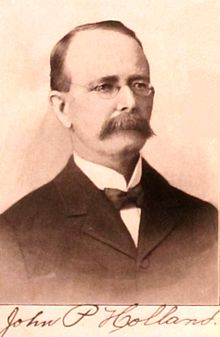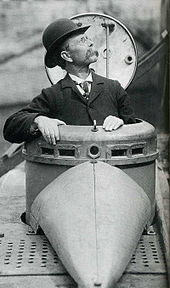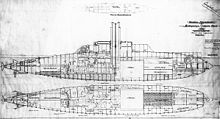John Philip Holland
John Philip Holland ( Irish Seán Ó Maolchalann ; born February 24, 1841 in Liscannor , Ireland ; † August 12, 1914 in Newark , USA ) was an Irish-American inventor. He constructed the first practically deployed submarines for the US Navy and some other navies at the beginning of the 20th century .
Life
Youth in Ireland - Submarine Dreams
John Philip Holland was born as the second of the four sons of Máire Ní Scannláin Holland and John Holland in Liscannor in the western Irish county of Clare . Since only Irish was spoken in his family, he first learned the English language at a public school. He later attended Catholic religious schools in Ennistymon and Limerick . Already in his youth he was concerned with the theory of underwater vehicles and read the writings of David Bushnell , William Bourne and Robert Fulton . As an Irish patriot, he hoped to be able to fight the overwhelming British Navy with underwater vehicles . In 1858 John Philip Holland joined the Catholic Order of the Irish Christian Brothers and became a teacher. When he read about the unsuccessful Intelligent Whale in 1869 , he began to deal intensively and systematically with his childhood dream. Holland left the order in 1873 and emigrated to the USA, where he hoped to find donors for his project.
First years in the USA - submarines for the freedom of Ireland
Holland moved to Boston , where his mother and brothers lived. He soon left his family and initially worked again as a teacher in Paterson (New Jersey) .
During this time, his younger brother Michael introduced him to the Fenian United Brotherhood (Fenians). The Fenians were the American wing of the Irish Republican Brotherhood . The foreign organization supported the struggle for independence in the Irish homeland with money and weapons, but also in some cases with terrorist attacks. Holland was able to convince the financially strong organization to provide funds for a first submarine test construction. As early as 1875 he had submitted a corresponding draft to the US Navy, but it was rejected as "not feasible". The Fenians planned to use merchant ships to approach British warships and submerge submarines unnoticed, which would then torpedo them. The romantic patriots or international terrorists, depending on their perspective, were certainly inspired by the book 20,000 Leagues Under the Sea by the French author Jules Verne , published in 1870 .
Under the leadership of Holland, six submarine designs were created one after the other, the first four of which were for the Fenians. The first boat, the Holland I , was built at Albany City Iron Works in Albany in 1877 . The iron construction displaced just 2 tons left. and had a petroleum engine with an output of 4 hp . Although the engine was much too small, the test drives on the Passaic River convinced the Fenians. Funds for a larger construction were promised and the test boat was sunk. The wreck was lifted in 1927. It has since been on display at the Paterson Museum.
In 1879 Holland gave up his teaching job and worked exclusively for the Irish Freedom Fighters' submarine project. In the same year construction began on a much larger boat. A smaller test model was also built.
The second boat was the Fenian Ram , also known chronologically as Holland II . She was laid down at Delamater Iron Works in New York on May 3, 1879 and launched in April 1881 . The cigar-shaped boat displaced 19 ts and was equipped with a compressed air cannon. The gun was not unlike modern torpedo discharge tubes and fired projectiles at around 50 m. A decisive innovation in the concept was that the power submerging the boat was not simply made available via ballast tanks , as in previous submersible designs . The boat had a slight static buoyancy when diving . It only dives down by giving the boat dynamic downforce as it moves forward . Airships use a similar principle to ascend. The boat and compressed air cannon have been extensively tested, reaching depths of 18 m. However, Holland got into an argument with the Fenians, who then kidnapped the boat to New Haven , where it was abandoned and stored in a shed because no one could operate the complicated construction. The Fenian Ram was on public display in New York City in 1916 to raise funds for the victims of the British intervention following the Easter Rising . The boat is now in the Paterson Museum.
At the same time, the Fenian Model ( Holland III ), a considerably smaller test boat, was built in Jersey City . But it sank soon after it was launched.
Later years - the breakthrough
After breaking with the Fenians, Holland worked for some time as a draftsman in New York City.
Between 1885 and 1886 he designed a wooden boat for Army Lieutenant Edmund Zalinski in Fort Lafayette . Work later continued at Fort Hamilton . The boat was intended as a test platform for the pneumatic torpedo cannon developed by Zalinski. The design known as Holland IV was badly damaged when it was launched and could not be used.
On January 17, 1887, Holland married Margeret Foley. The marriage produced seven children, two of whom died young.
As a reaction to the European successes in submarine construction, the US Navy issued a tender in 1888 . The search was on for a boat that could operate under water at 8 knots at a depth of up to 45 m for two hours and which reached a cruising speed of 15 knots on the surface. Holland took part in the competition and was able to prevail against its competitor Simon Lake . But the design was not built. When there was another tender by the US government in 1893, Holland founded the Holland Torpedo Boat Company together with the lawyer Elihu B. Frost, who contributed the capital . A new design was developed and on August 7, 1897, the plunger was launched in Baltimore . The whole construction was a failure and was not finished. Holland decided to repay part of the prize money won in the competition to the Ministry of the Navy and to use the rest of the money to realize another, much more significant design.
This submersible, the Holland VI , was launched on May 17, 1897 and was to become the first major success. The 74 ts displacement structure was powered over water by a 50 hp petroleum motor. As in modern submarines to this day, battery-powered electric motors were used under water. The boat had an above water range of 865 nautical miles, which is about 1,600 km. As armament served a torpedo tube that 457 mm Whitehead - torpedoes could fire. It could be reloaded twice. The crew consisted of 9 men, but their living conditions were very poor.
After a two-year test phase, the submarine was bought by the US Navy and put into service on October 12, 1900 as USS Holland with the newly created ship identification SS-1 (for Ship Submersible ). Shortly before, the new weapon had proven its effectiveness in September 1900, when the submarine was able to approach the battleship USS Kearsarge unnoticed within 100 m during a fleet maneuver and simulated a torpedo attack. The USS Holland was, apart from the early attempts from the War of Independence and the War of Secession , the first operational submarine of the US Navy.
In the same year, the Holland Torpedo Boat Company merged with the Electric Boat founded by Isaac Rice . Electric Boat is now a subsidiary of General Dynamics and built many US nuclear submarines during the Cold War .
With the capital of Electric Boat , the growing customer base could now be served. At the same time, after the success, there was great interest in submarines worldwide. Holland further developed the design to the Holland VII boat, a prototype of which, the Fulton , was built. The enlarged version displaced 120 ts and was called the plunger class (also adder class or A class). Between 1900 and 1906, 24 boats were built and sold to various navies. The first foreign customer for Holland's boat was, ironically, the British Navy, which ordered five boats in 1900. This on the Adder based boats were by Vickers in Barrow-in-Furness manufactured under license.
Overall, the distribution of the Holland boats was as follows:
- U.S. Navy: 7
- Imperial Japanese Navy : 5 (pre-assembled in the USA, completed in Japan)
- British Navy : 5 (license build), named HMS Holland 1 to HMS Holland 5
- Dutch Navy : 1 (license build)
- Russian Navy , Som class : 7 (6 license builds)
In March 1904, Holland left the Electric Boat in dispute. In the remaining years of his life he developed further submarine concepts, but found no sponsors. He was unable to market his designs under the renowned Holland name because Electric Boat had secured the naming rights.
John Philip Holland died on August 12, 1914 in Newark (New Jersey) of complications from pneumonia.
On the occasion of the 100th anniversary of his death, Ireland issued a commemorative coin in 2014.
literature
- Robert Hutchinson: Fight Under Water - Submarines from 1776 to the Present . 1st edition. Motorbuchverlag, Stuttgart 2006, ISBN 3-613-02585-X
- Anthony Preston: The History of the Submarines . Karl Müller Verlag, Erlangen 1998, ISBN 3-86070-697-7
Web links
- CV and constructions (English)
- Simply written resume (English)
- Detailed CV (English)
- Images of Holland boats (English)
| personal data | |
|---|---|
| SURNAME | Holland, John Philip |
| ALTERNATIVE NAMES | Maolchalann, Seán Ó |
| BRIEF DESCRIPTION | Irish-American submarine designer |
| DATE OF BIRTH | February 24, 1841 |
| PLACE OF BIRTH | Liscannor , County Clare, Ireland |
| DATE OF DEATH | August 12, 1914 |
| Place of death | Newark, New Jersey , USA |





